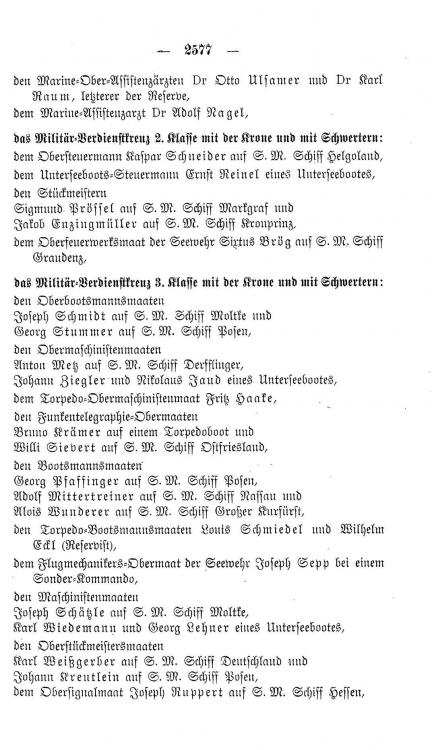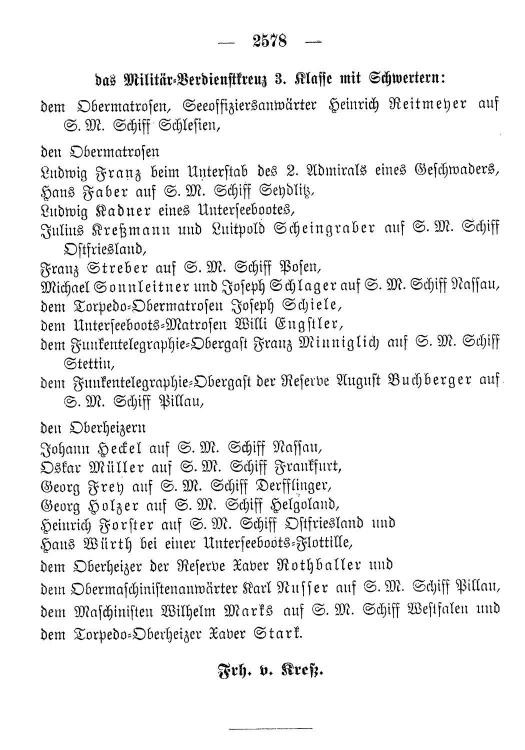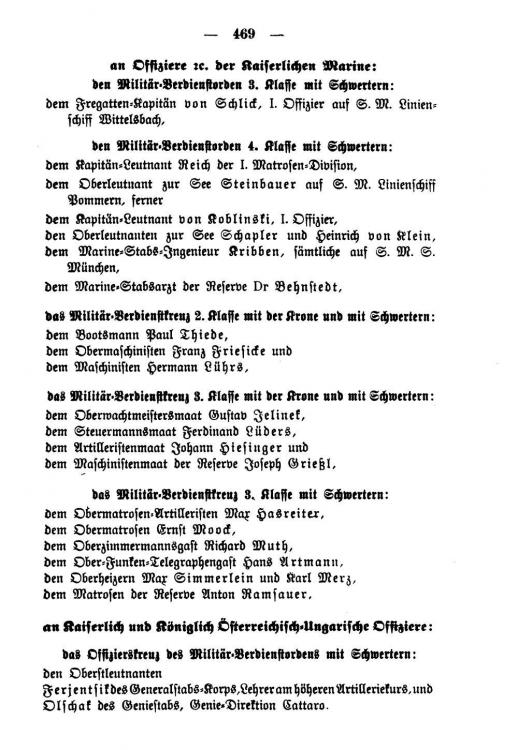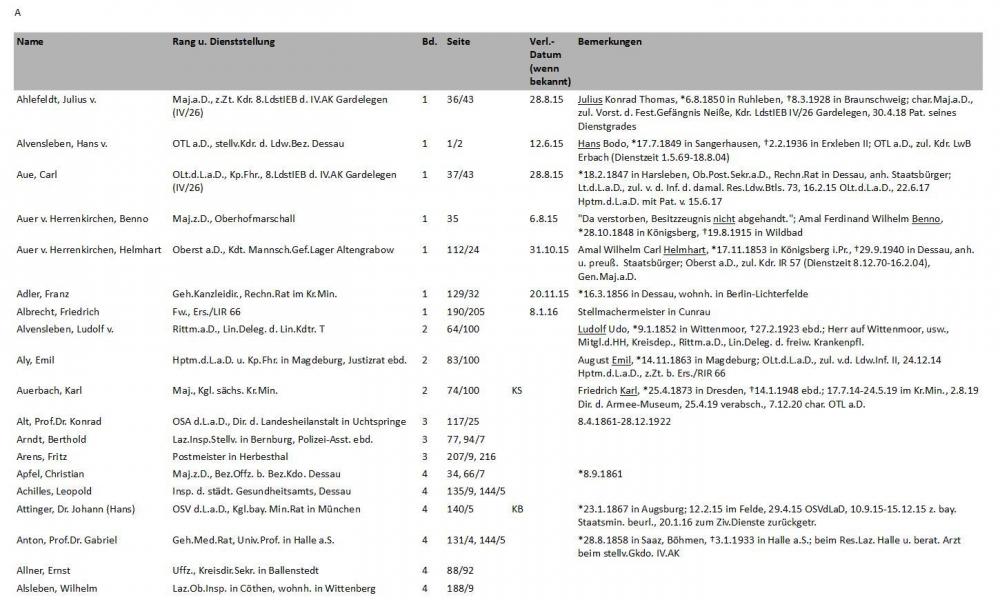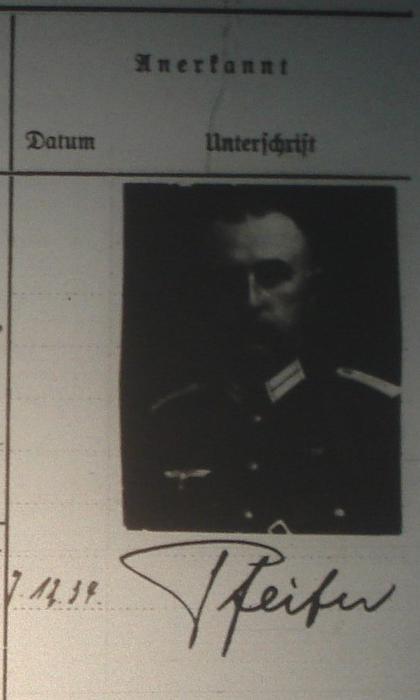-
Posts
4,908 -
Joined
-
Last visited
-
Days Won
97
Content Type
Profiles
Forums
Blogs
Gallery
Events
Store
Everything posted by Dave Danner
-

Unknown award Please help
Dave Danner replied to Kriegsmarine Admiral's topic in Wehrmacht Medals, Decorations & Awards
Nothing immediately comes to mind for me. The date for his Friedrichkreuz, by the way, is 6.5.1918. -
The Gefechtskalender for RIR 88 has them there from 15 July to 2 September. There are 1826 names in the Verlustlisten for RIR 88 between August 1916 and the end of October (there's a lag of a few weeks between the loss itself and the publication of the list). That includes two big lists on 11.9.1916 with 1300 names and on 26.9.1916 with 341 names. Some of the entries are corrections to earlier entries (e.g. from MIA to KIA), but that's roughly 1800 killed/wounded/missing in seven weeks of combat.
-
I have his name from one of my colleagues in Mecklenburg who has gone through the rolls. Remember that the 1918 rank list was as of 14 February 1918. So that is nine months' worth of awards between then and the end of the war. And Mecklenburg-Schwerin continued to process awards until about 1924. Oldenburg was another state which continued to process awards into the 1920s. Since both of these are maritime states, that means that there may be lots of navy awards that do not show up in the rank list. I am not sure about Hamburg, but I think it is likely they also processed awards after November 1918. Also, for many officers, the information in the rank list was not current as of 14 February 1918. For example, Lt.z.S. Heinrich Fabig received the Schwarzburg Ehrenkreuz 3.Klasse mit Schwertern on 30 November 1917, but is only shown with the EK2 in the rank list. Bruno Mahn received his Ehrenkreuz even earlier, on 28 March 1917, but is only shown with the EK1. Hermann Rohne received the Anhalt Friedrichkreuz on 26 March 1917, and is also only shown with the EK1. The later Konteradmiral Clamor von Trotha received the Anhalt Friedrichkreuz on 6 May 1918. Of course, that award does not show up in the 1918 rank list, but it is also missing in the 1922 and 1925 editions.
-
Regarding returning "enemy" awards, from an article in the Tierärztliche Rundschau: "Rückgabe eines japanischen Ordens. Dem Oberstabs- und Regimentsveterinär Heinrich Lütje im Ulanen-Rgt. Nr. 20 in Ludwigsburg wurde im Jahre 1903 der japanische Orden vom heiligen Schatz, 5. Klasse verliehen. Er hat bei Beginn des Krieges diesen Orden dem Württembergischen Roten Kreuz zur Verwertung überwiesen und in einem Schreiben an die japanische Botschaft erklärt, dass es ihm nicht möglich sei, eine Auszeichnung vom Herrscher eines Landes zu tragen, dessen Regierung sich in solch schamloser Weise dem deutschen Reiche gegenüber verhalte und zwar trotz aller Wohltaten, die dieses Land und seine Angehörigen von dem deutschen Reiche, insbesondere von seiner Heeresverwaltung, genossen hätten. (Bravo! Red.)"
-
Hintzmann did not have the Centenary Medal. He was in the Crew of 1897, entering service in April 1897, too late for the Centenary Medal which was awarded on 22 April 1897. The first three ribbons, as you guessed, are the EK2, HOH3X and MMV2. The last two are the Red Eagle with the barely visible Crown device and the Osmanieh. You're right that the foreign award is last. War awards precede peacetime awards, so the ribbon before the Red Eagle with swords is his Ehrenkreuz für Frontkämpfer. That leaves the two ribbons between the Mecklenburg award and the Ehrenkreuz für Frontkämpfer. They are war awards but are not in the 1918 rank list, so they must have been awarded after that list was published. Most likely, based on their appearance, they are the Hesse Allgemeines Ehrenzeichen "Für Tapferkeit" and the Hamburg Hanseatenkreuz, but I cannot say for certain.
-
Heinrich Max Albert Viktor. In the 1920 Berlin marriage register, he is identified as an Oberstleutnant a.D. and Landjägerrat. I assume the OTL was a Charakter promotion. He received the Lippe Kriegsverdienstkreuz on 18.9.1915 as a Maj.z.D. and Kdr. II./RIR 219. On his receipt for the LK, dated 8.10.1915, he identifies his other awards as the EK1, the Centenary Medal, the Hesse Allgemeines Ehrenzeichen "Für Tapferkeit" and the Austro-Hungarian Militärverdienstkreuz 3.Klasse mit der Kriegsdekoration 3.Klasse. As you can see in your picture, both the Centenary and the LK have the dark color which certain light-colored ribbons take in black-and-white photos. Yellow, white and red are about the same shade in the photo. He listed his residence as Burgsteinfurt in the LK receipt, but the Berlin register has him living in Berlin-Wilmersdorf in 1920. The 1. Gendarmerie-Brigade was in East Prussia, so I assume he was somewhere there from 1916 to 1918.
-
Of course, as soon as I hit enter above, I thought, "maybe I should check another source of mine". And what do I find: Cramer, Ludwig, * 18.4.1895 in Hamburg. He was commissioned a Leutnant in Dragoner-Regiment Nr. 6 on 2.3.1915, and went to the Fliegertruppe later that year. He served in FA 39, Jasta 3 and FA(A) 268. He returned to active duty on 15.9.1934 as a Hauptmann, was promoted to Major on 1.1.1939, Oberstleutnant on 1.12.1941 and Oberst on 1.7.1944. He was a Kompanie-Chef in Kavallerie-Schützen-Regiment 7 in the Austrian annexation and Poland campaign and a battalion commander in Schützen-Regiment 7 in the Western campaign (Rommel was his division commander). After that he was a staff officer and later served in Wehrersatzwesen. So the picture does predate the award of the WHDA4 on 2.10.1936. He also received the Anschluß Medal, the Spangen to both classes of the Iron Cross, the War Merit Cross 2nd Class with Swords, and the Panzerkampfabzeichen in Bronze.
-
Willy Friedrich Bernhard Otto Heldt, born 21.7.1896 in Tessin, Mecklenburg-Schwerin. Twice wounded in 1918. He received the MMV1 as a Leutnant der Reserve in MG-Scharfschützen-Abteilung Nr. 11. He probably received his MMV2 as a Gefreiter in MG-Scharfschützen-Abteilung Nr. 20, but I can't be sure, as there are a bunch of awards with that name gazetted in the Regierungsblatt.
-
Andreas, here are some Marine equivalents: • MVK 2. Klasse mit Krone und Schwertern: Oberdeckoffiziere/Deckoffiziere (z.B. Oberbootsmann, Bootsmann, Steuermann, Flugmechaniker) • MVK 2. Klasse mit Schwertern: Vizedeckoffiere (Reserveoffizieranwärter der Marine, z.B. Vizesteuermann, Vizefeuerwerker, Vizemachinist, Vizeflugmeister), Unteroffiziere mit Portepee (z.B. Wachtmeister im seemännischen Dienst) • MVK 3. Klasse mit Krone und Schwertern: Unteroffiziere ohne Portepee (Maate) (z.B. Oberbootsmannsmaat, Bootsmannsmaat, Steuermannsmaat, Signalmaat, Flugmaat) • MVK 3. Klasse mit Schwertern: Mannschaften (Matrosen) (z.B. Obermatrose, Obersignalgast, Signalgast, Heizer, Zimmermannsgast, Seesoldat) There was no navy equivalent of Feldwebelleutnant. I am not sure of any navy recipients of the 1st Class, except for maybe a Feldhilfsarzt or Beamter?
-
A lot less than 1600. There were 1170 awards. I have the names all typed up, but I am still adding in information from the Vorschläge. The actual Anhalt "rolls" were just a list of names, ranks and units, with a cross-reference number to the volume and page where the award was approved. These volumes of recommendations and approval resolutions were stored in a basement in Oranienbaum, east of Dessau, during the communist era, and many were lost or severely water-damaged. If you want, you can let me know what are on your bars and I can check my work-in-progress. I might already have a possible match. As I have mentioned before, my goal is more than a list of awards, but also a bit of information on the people who received them. I suppose I may have bit off more than I can chew. Here is an example of my work in progress. Please let me know if you think it is too busy or clunky, too many abbreviations, or any other criticisms.
-
The Heinemann in the Ehrenrangliste from FAR 15 and in the Reichswehr was the later General der Artillerie Erich Heinemann. As Daniel noted in his reply to you in February 2009, the only other candidate would be a Hauptmann der Reserve Heinemann whose HOH3X was gazetted in the Militär-Wochenblatt on 24.08.1918. No other HOH3Xs to anyone named Heinemann are known, although there are a few very late-war awards that were never gazetted. So if it came in late October or early November 1918, it might still be out there waiting to be discovered. I have looked over every reserve officer who would have been a Hptm.d.R. in 1918, and found only three. One was named Otto, but none of them are artillery officers, and this Otto was not likely later a colonel. He is: Heinemann, Otto, *25.5.1865 in Langenau; Landesmeliorationsbaumeister beim Provinzial-Verbandes der Provinz Ostpreußen • 18.11.1893 Sekonde-Lieutenant d.R. des Pionier-Bataillons Nr. 1 • 18.06.1903 Oberleutnant d.R. • 21.04.1911 Hauptmann d.R. • 30.09.1918 Charakter als Major d.R. • living as a Landesbaurat and Maj.d.R.a.D. in Königsberg according to the 1931 Mitgliederverzeichnis for PB 1 His known decorations are the Roter-Adlerorden 4. Klasse, Eisernes Kreuz 1. Klasse, Landwehr-Dienstauszeichnung 1. Klasse and Österreich-Ungarisches Militärverdienstkreuz 3. Klasse mit der Kriegsdokoration. The other two Hauptleute der Reserve were Martin from the reserve of Pionier-Bataillon Nr. 4 and Rudolf from the reserve of Telegraphen-Bataillon Nr. 6. Martin was a Baumeister in Putbus. Rudolf was a Postinspektor in Halle a.S., later in Oldenburg. I was unable to rule out any of these three as Daniel's HOH3X recipient. Do you have any other information on your relative which might shed some light? Or maybe there was a mix up in your family history between Otto and the later-general Erich Heinemann?
-
I looked through the battalion history a few years' ago. There wasn't any information there. The RJB 4 history has a list of award numbers to that unit, which shows that Reuß awards were second only to Prussian awards in the battalion. I would imagine the numbers were similar for JB 4. The Deutsche Forst-Zeitung also published a list of Reuß awards to JB 4 in 1914 and early 1915, but I have yet to find any lists for later war years. There were 49 silver medals with swords in that list, with the recipients ranging from Vizefeldwebel to Jäger. Here is the RJB 4 table:
-
The recipient was most likely not a native of Reuß. The three most common ways to receive an award from one of the German states were (1) be a native of the state, (2) serve in that state's contingent, or (3) serve in a unit whose Chef or Inhaber was the ruler of a state. We often overlook this third category, but it was pretty common. In this case, the most likely connection is Jäger-Bataillon Nr. 4 of the Ostsee-Division. The Chef of Jäger-Bataillon Nr. 4 was Heinrich XXVII. Fürst Reuß j.L., the ruling prince of Reuß-Gera and regent of Reuß-Greiz. There are no complete rolls for Reuß awards, but there are many known awards to JB 4 officers and men from other sources.
-
Far below generals. The 2nd Class was awarded mainly to majors and captains in the army and to naval officers in the rank of Kapitänleutant and Korvettenkapitän. Also officials of equivalent rank, such as medical officers. I'm not sure, but I think Germans got a "bump up" in the class they received, which often happens with foreign officers receiving a country's awards. Maybe one of our Finnish members can confirm, but I think a Finn would normally need to be around the rank of colonel or lt. colonel to receive the 2nd Class.
-
For the Ostsee-Division, I have the names of about 60 of an estimated 64 recipients of the 2nd class. Most were company and squadron commanders in 1918 and not old enough to have served in China. This does not include naval officers or others who might have been in Finland outside of the Ostsee-Division and the staff of the Deutscher General in Finnland. About half of the 40,000 or so recipients of the China Medal for combatants were naval personnel. I have no idea how they break down by officers whose medal bars might be traceable and petty officers and sailors whose bars would likely not be traceable. German land forces in the China Expedition amounted to about 19,000 soldiers, of whom about 1,000 were officers and officials in officer rank. There is a rank list of these officers online, but the website is currently down.
-
The head of the Ascanian House is Eduard Prinz von Anhalt (1941-), son of Joachim Ernst Herzog von Anhalt (1901-1947). That is not him in the picture. The guy in your picture is Frédéric "Prinz von Anhalt", born in 1943 as Hans-Robert Lichtenberg. In 1980, at the age of 36, he arranged to be adopted by the elderly widow Marie Auguste Prinzessin von Anhalt (1898-1983), sister of Herzog Joachim Ernst. She was apparently poor and lonely after the death in 1975 of her only son Karl Franz Prinz von Preußen, and the person who arranged the adoption helped pay her rent. Frédéric has since adopted 10 adults himself, making them so-called princes of Anhalt, as well as selling various knighthoods. The Albert the Bear is a House Order, and he is not head of, or in reality a member of, the House, so his "knighthoods" are pretty much worthless. Frédéric bought the ones he wears from various dealers and auctions. Since Germany does not have titles of nobility, the "Prinz" in Frédéric's name, as well as his adopted "sons", is merely a part of a legal name change, and no more a title than that of Prince Rogers Nelson or Elvis "The King" Presley. https://en.wikipedia.org/wiki/Frédéric_Prinz_von_Anhalt


